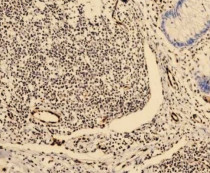ARG66770
anti-ERG antibody [SQab20203]
anti-ERG antibody [SQab20203] for IHC-Formalin-fixed paraffin-embedded sections,Western blot and Human

1
Overview
| Product Description | Recombinant Rabbit Monoclonal antibody [SQab20203] recognizes ERG |
|---|---|
| Tested Reactivity | Hu |
| Tested Application | IHC-P, WB |
| Host | Rabbit |
| Clonality | Monoclonal |
| Clone | SQab20203 |
| Isotype | IgG |
| Target Name | ERG |
| Antigen Species | Human |
| Immunogen | Synthetic peptide within aa. 450 to C-terminus of Human ERG. |
| Conjugation | Un-conjugated |
| Alternate Names | p55; Transcriptional regulator ERG; Transforming protein ERG; erg-3 |
Application Instructions
| Application Suggestion |
|
||||||
|---|---|---|---|---|---|---|---|
| Application Note | IHC-P: Antigen Retrieval: Heat mediation was performed in Tris/EDTA buffer (pH 9.0). * The dilutions indicate recommended starting dilutions and the optimal dilutions or concentrations should be determined by the scientist. |
||||||
| Positive Control | Appendix tissue; Molt-4 |
Properties
| Form | Liquid |
|---|---|
| Purification | Purification with Protein A. |
| Buffer | PBS, 0.01% Sodium azide, 40% Glycerol and 0.05% BSA. |
| Preservative | 0.01% Sodium azide |
| Stabilizer | 40% Glycerol and 0.05% BSA |
| Storage Instruction | For continuous use, store undiluted antibody at 2-8°C for up to a week. For long-term storage, aliquot and store at -20°C. Storage in frost free freezers is not recommended. Avoid repeated freeze/thaw cycles. Suggest spin the vial prior to opening. The antibody solution should be gently mixed before use. |
| Note | For laboratory research only, not for drug, diagnostic or other use. |
Bioinformation
| Database Links | |
|---|---|
| Gene Symbol | ERG |
| Gene Full Name | v-ets avian erythroblastosis virus E26 oncogene homolog |
| Background | This gene encodes a member of the erythroblast transformation-specific (ETS) family of transcriptions factors. All members of this family are key regulators of embryonic development, cell proliferation, differentiation, angiogenesis, inflammation, and apoptosis. The protein encoded by this gene is mainly expressed in the nucleus. It contains an ETS DNA-binding domain and a PNT (pointed) domain which is implicated in the self-association of chimeric oncoproteins. This protein is required for platelet adhesion to the subendothelium, inducing vascular cell remodeling. It also regulates hematopoesis, and the differentiation and maturation of megakaryocytic cells. This gene is involved in chromosomal translocations, resulting in different fusion gene products, such as TMPSSR2-ERG and NDRG1-ERG in prostate cancer, EWS-ERG in Ewing's sarcoma and FUS-ERG in acute myeloid leukemia. More than two dozens of transcript variants generated from combinatorial usage of three alternative promoters and multiple alternative splicing events have been reported, but the full-length nature of many of these variants has not been determined. [provided by RefSeq, Apr 2014] |
| Function | Transcriptional regulator. May participate in transcriptional regulation through the recruitment of SETDB1 histone methyltransferase and subsequent modification of local chromatin structure. [UniProt] |
| Cellular Localization | Nucleus. Cytoplasm. Note=Localized in cytoplasmic mRNP granules containing untranslated mRNAs. [UniProt] |
| Calculated MW | 55 kDa |
Images (2) Click the Picture to Zoom In
-
ARG66770 anti-ERG antibody [SQab20203] WB image (Customer's Feedback)
Western blot: Molt-4 cell lysate stained with ARG66770 anti-ERG antibody [SQab20203] at 1:1000 dilution.
-
ARG66770 anti-ERG antibody [SQab20203] IHC-P image
Immunohistochemistry: Formalin/PFA-fixed and paraffin-embedded Human appendix tissue. Antigen Retrieval: Heat mediation was performed in Tris/EDTA buffer (pH 9.0). The tissue section was stained with ARG66770 anti-ERG antibody [SQab20203] at 18°C - 25°C for 30 minutes.









